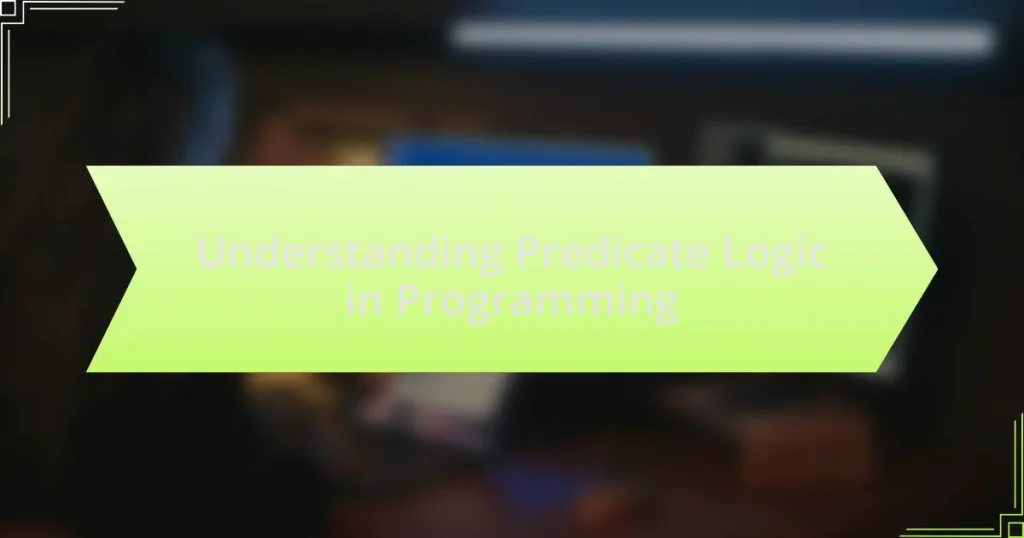The article explores the interplay between logic programming and functional programming, highlighting their shared declarative paradigms and distinct approaches to computation. It examines how logic programming, exemplified by Prolog, focuses on expressing facts and rules for automated reasoning, while functional programming, represented by Haskell, emphasizes functions and immutability. The integration of these paradigms is discussed, showcasing their complementary strengths in problem-solving, efficiency, and code clarity. Additionally, the article addresses the challenges of combining these approaches, real-world applications, and best practices for effective integration, ultimately demonstrating the benefits of leveraging both paradigms in software development.

What is the Interplay Between Logic Programming and Functional Programming?
The interplay between logic programming and functional programming lies in their shared emphasis on declarative paradigms, where the focus is on what to compute rather than how to compute it. Logic programming, exemplified by languages like Prolog, allows for expressing facts and rules, enabling automated reasoning and problem-solving through logical inference. Functional programming, represented by languages such as Haskell, emphasizes the use of functions as first-class citizens and immutable data, promoting a mathematical approach to computation.
Both paradigms can be integrated, as seen in languages like Mercury, which combines features of both logic and functional programming. This integration allows for leveraging the strengths of each paradigm; for instance, functional programming’s strong type systems can enhance the reliability of logic programming’s inference mechanisms. Research has shown that such hybrid approaches can lead to more efficient algorithms and clearer code structures, demonstrating the practical benefits of their interplay in software development.
How do Logic Programming and Functional Programming differ?
Logic Programming and Functional Programming differ primarily in their approach to computation. Logic Programming is based on formal logic and uses rules and facts to derive conclusions, while Functional Programming emphasizes the evaluation of functions and avoids changing state or mutable data. In Logic Programming, programs consist of a set of logical statements, and execution involves querying these statements to infer new information, as seen in languages like Prolog. In contrast, Functional Programming treats computation as the evaluation of mathematical functions, with languages such as Haskell exemplifying this paradigm. The distinction lies in Logic Programming’s focus on what is true and how to derive truths, whereas Functional Programming centers on how to transform data through function application.
What are the fundamental principles of Logic Programming?
The fundamental principles of Logic Programming include the use of formal logic as a programming paradigm, where programs are expressed in terms of relations and rules rather than explicit control flow. Logic Programming relies on a declarative approach, allowing the programmer to specify what the program should accomplish without detailing how to achieve it.
Key aspects include the use of facts, rules, and queries, where facts represent known information, rules define relationships and infer new information, and queries are used to retrieve information based on the defined facts and rules. The most notable example of Logic Programming is Prolog, which employs these principles to solve problems through logical inference.
These principles are validated by the effectiveness of Logic Programming in areas such as artificial intelligence and computational linguistics, where the ability to represent complex relationships and perform automated reasoning is crucial.
What are the core concepts of Functional Programming?
The core concepts of Functional Programming include first-class functions, pure functions, immutability, higher-order functions, and recursion. First-class functions allow functions to be treated as first-class citizens, meaning they can be passed as arguments, returned from other functions, and assigned to variables. Pure functions are those that always produce the same output for the same input and do not cause side effects, enhancing predictability and testability. Immutability refers to the inability to change data once it has been created, which helps prevent unintended side effects and makes reasoning about code easier. Higher-order functions are functions that can take other functions as arguments or return them as results, enabling powerful abstractions. Recursion is a technique where a function calls itself to solve smaller instances of a problem, often replacing traditional looping constructs. These concepts collectively promote a declarative programming style, emphasizing what to solve rather than how to solve it, which is foundational in Functional Programming.
Why is the interplay between these two paradigms significant?
The interplay between logic programming and functional programming is significant because it enhances problem-solving capabilities by combining declarative and functional paradigms. Logic programming focuses on expressing facts and rules about problems, allowing for automated reasoning, while functional programming emphasizes the use of functions and immutability, promoting clearer and more predictable code. This synergy enables developers to leverage the strengths of both paradigms, leading to more efficient algorithms and improved software reliability. For instance, languages like Prolog and Haskell demonstrate this interplay, where Prolog’s logical inference can be integrated with Haskell’s functional constructs, resulting in powerful tools for artificial intelligence and complex data manipulation.
How do they complement each other in problem-solving?
Logic programming and functional programming complement each other in problem-solving by leveraging their distinct strengths to address complex issues more effectively. Logic programming excels in declarative problem-solving, allowing users to specify what the solution should satisfy without detailing how to achieve it, which is particularly useful for tasks involving constraints and relationships. In contrast, functional programming emphasizes immutability and first-class functions, enabling clear and concise expression of algorithms and facilitating easier reasoning about code behavior.
When combined, logic programming can handle the high-level problem specification while functional programming can implement efficient algorithms to derive solutions. For example, in artificial intelligence applications, logic programming can define rules and relationships, while functional programming can process data transformations and computations efficiently. This synergy enhances the overall problem-solving capability, making it possible to tackle a wider range of challenges effectively.
What challenges arise from integrating Logic and Functional Programming?
Integrating Logic and Functional Programming presents challenges such as differing execution models and variable handling. Logic programming relies on a declarative paradigm where the focus is on what to solve, while functional programming emphasizes how to solve problems through function application. This fundamental difference can lead to difficulties in combining the two paradigms effectively.
Additionally, the treatment of variables poses a significant challenge; in logic programming, variables can be unbound and represent multiple values, whereas functional programming typically uses immutable variables. This discrepancy complicates the integration process, as developers must reconcile these contrasting approaches to variable management.
Moreover, the performance implications of combining these paradigms can be substantial, as the overhead of logic-based inference mechanisms may hinder the efficiency of functional programming’s execution model. These challenges necessitate careful design considerations to achieve a seamless integration of Logic and Functional Programming.

How do Logic Programming and Functional Programming interact in practice?
Logic Programming and Functional Programming interact in practice through the use of shared concepts such as higher-order functions and recursion, enabling the expression of complex computations. In Logic Programming, languages like Prolog utilize logical relations to derive conclusions, while Functional Programming languages like Haskell emphasize the use of functions as first-class citizens. This interaction allows for the implementation of logic-based paradigms within functional frameworks, facilitating tasks such as constraint solving and symbolic reasoning. For instance, Prolog can be embedded within Haskell, allowing developers to leverage Prolog’s inference capabilities alongside Haskell’s functional constructs, demonstrating a practical synergy between the two paradigms.
What are some real-world applications of their interplay?
The interplay between logic programming and functional programming has several real-world applications, particularly in areas such as artificial intelligence, natural language processing, and automated theorem proving. For instance, Prolog, a logic programming language, is often used in AI for tasks like knowledge representation and reasoning, while functional programming languages like Haskell are utilized for their strong type systems and concurrency features. In natural language processing, combining these paradigms allows for more expressive models that can handle complex linguistic structures. Additionally, in automated theorem proving, the integration of both paradigms enhances the ability to reason about mathematical statements and verify proofs efficiently. These applications demonstrate the practical benefits of leveraging the strengths of both programming paradigms in solving complex problems.
How is Logic Programming used within Functional Programming environments?
Logic programming is utilized within functional programming environments primarily through the integration of declarative paradigms that allow for reasoning about program behavior. In functional programming, logic programming techniques enable the expression of complex relationships and constraints, facilitating tasks such as constraint satisfaction and symbolic reasoning. For instance, languages like Prolog can be embedded within functional languages, allowing developers to leverage logic-based queries alongside functional constructs. This integration enhances the expressiveness and flexibility of programs, enabling more sophisticated problem-solving capabilities.
What examples illustrate successful integration of both paradigms?
Prolog and Haskell exemplify successful integration of logic programming and functional programming. Prolog, a logic programming language, can be embedded within Haskell, allowing developers to leverage Prolog’s declarative nature alongside Haskell’s functional capabilities. This integration facilitates complex problem-solving, such as in artificial intelligence applications, where Prolog’s reasoning abilities complement Haskell’s strong type system and functional constructs. Additionally, the Curry-Howard correspondence illustrates the relationship between logic and functional programming, where types in Haskell correspond to logical propositions, enabling seamless transitions between the two paradigms in practical applications.
What tools and languages facilitate this interplay?
Prolog and Haskell are two primary languages that facilitate the interplay between logic programming and functional programming. Prolog, a logic programming language, excels in symbolic reasoning and non-numeric computation, while Haskell, a functional programming language, emphasizes immutability and higher-order functions. The integration of these languages allows for the development of systems that leverage the strengths of both paradigms, such as using Prolog for rule-based reasoning and Haskell for functional data manipulation. This synergy is evident in projects like Curry, which combines features of both paradigms, demonstrating their compatibility and enhancing computational capabilities.
Which programming languages support both Logic and Functional Programming?
Prolog and Scala are programming languages that support both Logic and Functional Programming. Prolog is primarily a logic programming language, but it incorporates functional programming features, allowing for a declarative style of coding. Scala, on the other hand, is a hybrid language that combines object-oriented, functional, and logic programming paradigms, enabling developers to use logical constructs alongside functional programming techniques. This versatility in both languages demonstrates their capability to blend these two programming paradigms effectively.
What frameworks enhance the collaboration between these paradigms?
The frameworks that enhance collaboration between logic programming and functional programming include Prolog, Curry, and Mercury. Prolog facilitates logic programming with its declarative nature, allowing for the expression of complex relationships and rules, while Curry integrates functional and logic programming paradigms, enabling seamless transitions between them. Mercury, designed for high-performance logic programming, incorporates functional programming concepts to improve efficiency and maintainability. These frameworks exemplify how combining features from both paradigms can lead to more powerful and flexible programming solutions.

What are the implications of combining Logic and Functional Programming?
Combining Logic and Functional Programming enhances problem-solving capabilities by integrating declarative reasoning with higher-order functions. This integration allows for more expressive and concise code, enabling developers to define complex relationships and constraints more naturally. For instance, languages like Prolog can benefit from functional paradigms to manage state and side effects more effectively, while functional languages can leverage logical constructs to improve expressiveness in queries and data manipulation. The implications also include improved modularity and reusability of code, as both paradigms encourage the use of pure functions and logical assertions, leading to clearer and more maintainable software systems.
How does this combination affect software development?
The combination of logic programming and functional programming enhances software development by promoting declarative problem-solving and enabling higher-order functions. Logic programming allows developers to express complex relationships and constraints succinctly, while functional programming emphasizes immutability and first-class functions, leading to more predictable and maintainable code. This synergy results in improved code clarity and reduced side effects, which are critical for debugging and testing. For instance, languages like Prolog and Haskell exemplify this interplay, where Prolog’s logical inference capabilities complement Haskell’s functional paradigms, facilitating the development of robust applications that can efficiently handle complex data and logic.
What benefits does the interplay provide to developers?
The interplay between logic programming and functional programming provides developers with enhanced problem-solving capabilities and improved code efficiency. This synergy allows developers to leverage the declarative nature of logic programming, which focuses on what the program should accomplish, alongside the expressive power of functional programming, which emphasizes how to achieve those goals through functions and immutability. As a result, developers can create more concise and maintainable code, reducing the likelihood of bugs and improving overall productivity. Additionally, the combination of these paradigms facilitates better reasoning about code behavior, enabling developers to implement complex algorithms more intuitively and effectively.
How does it influence code maintainability and readability?
The interplay between logic programming and functional programming significantly enhances code maintainability and readability. Logic programming emphasizes declarative constructs, allowing developers to express the logic of computation without detailing control flow, which simplifies understanding and modifying code. Functional programming promotes immutability and first-class functions, leading to clearer data transformations and reduced side effects, making the code easier to follow and maintain. Studies have shown that codebases utilizing these paradigms exhibit fewer bugs and are easier to refactor, as evidenced by research from the University of Cambridge, which found that teams using functional programming languages reported a 40% reduction in maintenance time compared to those using imperative languages.
What best practices should be followed when integrating these paradigms?
When integrating logic programming and functional programming, best practices include ensuring clear separation of concerns, leveraging the strengths of each paradigm, and maintaining code readability. Clear separation of concerns allows developers to utilize logic programming for declarative problem-solving while employing functional programming for managing side effects and state. Leveraging strengths means using logic programming for tasks that require complex rule-based reasoning and functional programming for tasks that benefit from higher-order functions and immutability. Maintaining code readability is crucial, as it facilitates collaboration and future maintenance; this can be achieved by adhering to consistent naming conventions and documentation practices. These practices enhance the effectiveness of integration, leading to more robust and maintainable codebases.
How can developers effectively leverage both Logic and Functional Programming techniques?
Developers can effectively leverage both Logic and Functional Programming techniques by integrating declarative problem-solving approaches from Logic Programming with the higher-order functions and immutability principles of Functional Programming. This integration allows developers to express complex problems in a more natural and concise manner, enhancing code readability and maintainability. For instance, using Logic Programming’s unification and backtracking capabilities alongside Functional Programming’s first-class functions can lead to more efficient algorithms in tasks such as constraint satisfaction and search problems. Research indicates that combining these paradigms can improve performance and reduce development time, as seen in projects that utilize Prolog for logic and Haskell for functional constructs, demonstrating the practical benefits of this hybrid approach.
What common pitfalls should be avoided in this integration?
Common pitfalls to avoid in the integration of logic programming and functional programming include misunderstanding the paradigms’ fundamental differences, which can lead to inefficient code. For instance, logic programming emphasizes declarative problem-solving, while functional programming focuses on function application and immutability. Failing to recognize these distinctions can result in performance issues, as logic-based constructs may not translate efficiently into a functional context. Additionally, neglecting to manage state effectively can cause complications, as functional programming typically avoids mutable state, which is often utilized in logic programming. This oversight can lead to unexpected behaviors and bugs in the integrated system.



